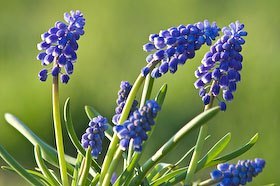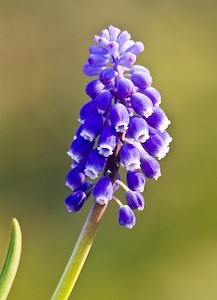Muscari or grape hyacinths are the cutest little bulb flowers you can choose for violet blue spring color.
The tiny, bell-shaped flowers, which are rimmed with white borders, grow in compact grape-like clusters.
Grape hyacinths are one of the easiest bulb flowers to grow in full sun or part shade, and they will spread to naturalize around shrubs, and complement early-flowering perennials.
They look particularly lovely matched with yellow flowers.
How to grow grape hyacinth

Delicate-looking grape hyacinth flower clusters
Photo: © Y.Cunnington
These bulbs are small, growing only about six to 10 inches (10-25 cm) tall.
Because they are small, be sure to plant plenty of bulbs (20 or more) in a grouping for maximum impact.
When planting, set bulbs four to five (10-12.5 cm) inches deep and three inches (8 cm) apart in well-drained soil, where there is no standing water over the winter or spring.
This bulb plant tends to send its foliage up in the fall, which means the leaves can get a bit tattered by winter if they’re not protected by lots of snow cover, but this never holds the flowers back.
The leaves popping up in fall can be a useful quality: for example, if you plant grape hyacinths together with taller bulbs like daffodils or tulips, this will help you remember where those bulbs are so you won’t spear them by mistake when planting something else.
How to design with grape hyacinths

Muscari armeniacum
Photo: © Y.Cunnington
Grape hyacinths look particularly attractive when matched with yellow flowers, such as daffodils, rock garden Drabas, basket-of-gold (Aurinia saxatilis), leopard’s bane (Doronicum orientale), or cushion spurge (Euphorbia polychroma).
You can also interplant them with a low-growing ground cover such as periwinkle, lily-of-valley or sweet woodruff and around deciduous flowering shrubs.
Grape hyacinth species
Muscari armeniacum is the most popular species. M. botryoides ‘Album’ has white flowers.
M. latifolium has a flower made up of sterile, light blue flowers that grow on top of fertile, dark purple-blue flowers.
More Spring Bulbs
More spring bulbs for naturalizing
Snowdrops – delicate flowers of early spring








